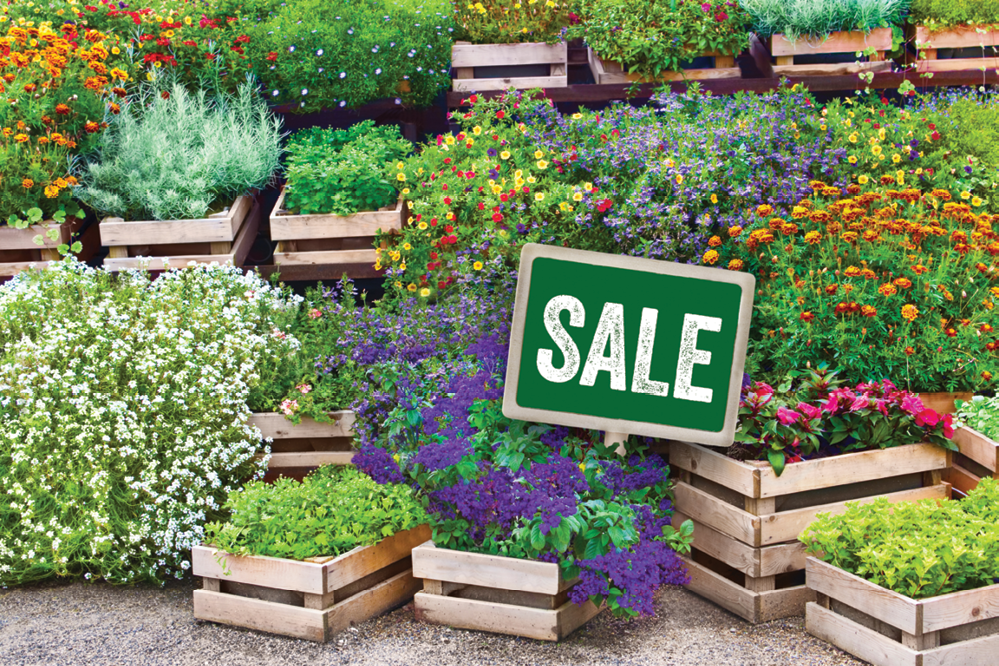

In the crowded garden retail space, where customers can choose to purchase garden and landscape plants at an independent garden center, a big box store, the local hardware store or online, how can independent garden centers best convey the extra value and expertise they bring to their products?
It’s a question Steve Bailey of Steve Bailey Consulting and financial adviser to The Garden Center Group, who specializes in helping garden centers become more profitable, has given a lot of thought to. And the answer, he says, is simple: “It comes down to the Three P’s: People, Product and Phacility.”

Bailey’s creative spelling notwithstanding, his message is clear. To convey real value to customers, an IGC has to have great staff members who are knowledgeable and customer-service oriented, great plants, and a facility that’s convenient to shop in. When those three things happen, customers will sense the value in what you’re providing and will seek you out, Bailey says.
That’s precisely what happened recently in California, when a 20-year customer at the SummerWinds Nursery location in San Jose, which had just closed, navigated eight miles of busy freeway interchanges to reach the next closest location in Campbell. Following the closure of her hometown SummerWinds store, she’d tried visiting other places but missed the expertise she’d come to expect from the IGC, says Jeff Christensen, SummerWinds’ hard goods buyer. “She told us she made a decision to come over to the Campbell store because she knew we had the knowledge to help her out with what she needed,” Christensen says. “She summed up our value-added perfectly.”
Looking for steps to increase value in the products you’re selling? Here are just a few:
1. Invest in staff training

To ensure customers sense your store’s deep industry knowledge — perhaps the single most important value-added asset IGCs can bring to the retail space — take time to invest in routine staff training. At SummerWinds, which has locations in both California and Arizona, the nursery holds product knowledge training sessions for staff featuring growers, hardwood vendors and plant experts multiple times per year, Christensen says.
2. Provide unique inventory
Specializing in unique, hard-to-find succulents was grower/owner Jared Hughes’s primary goal in opening Groovy Plants Ranch, based in Marengo, Ohio. The garden center also offers a full line of annuals, perennials and more, but it’s the uncommonly deep selection of succulents — including literal one-of-a-kinds — that has helped make Groovy Plants Ranch a favorite of both locals and residents in nearby Columbus. “We have very competitive pricing on all our standard succulents,” Hughes says. “But customers who come here may discover something like the Variegated String of Pearls, which they didn’t even know existed. And they’re willing to pay $15 for a 3.5 inch pot — which is a great margin for us — because they’ve never seen it anywhere else.”
3. Evaluate your product mix
Bailey believes garden center profit margins should range between 40 to 60 percent; expect a higher margin on perishable plants and a slightly lower margin on hardgoods, he says. With that in mind, thriving garden centers should aim to have more of their inventory aligned with plant goods and slightly less shelf space taken up by complementary products.
4. Turn inventory within the season

To keep customer foot traffic heavy, it’s important for garden centers to keep inventory fresh and in-season. Manage your ordering carefully, with a goal of selling as much product at full price as possible, Bailey says. Don’t rely on sales to liquidate inventory. Discounting and sales can send the wrong message to customers and potentially lead to an undercutting of your brand. “I already have very competitive price points. I have healthy product that we take a lot of pride in,” Hughes says. “I don’t want to create a culture where people wait for the sales.” To move inventory quickly, Hughes prefers quantity-purchase incentives, such as selling quart perennials for $5.99 each, or $5/each for five or more.




5. Make advertising a value-added tool
Recently, SummerWinds shifted its marketing focus from traditional print newspaper inserts with percent-off coupons to a digital-driven platform of weekly email newsletters and information-rich blog posts. Moving away from discounting plant material — especially during peak traffic season — was one driving force in the shift. But Christensen says the move has had multiple benefits: the newsletters allow the nursery to showcase its plant knowledge and target information directly to customers who are looking for it.
In a sense, online advertising has become another value-added aspect of SummerWinds’ business model. “One of our most popular posts was on roses,” Christensen says. “We compiled information from all of our growers and shared details on probably 200 different varieties in an email blast. The response was phenomenal. We actually sold more roses — at full price — this year than we did last year, when we featured them at 25 percent off in traditional print advertising.”


6. Be reactive to the market
Setting next season’s pricing takes careful planning and months of lead time. But you want to equip your business to be able to respond in real time, when needed, if market shifts are happening. Case in point: citrus trees. Because of a California citrus quarantine this year, citrus inventory plummeted and growers were limited in their ability to ship to certain locations. To account for higher grower costs and added shipping per unit, Christensen and his team had to raise their five-gallon citrus tree prices from $39.99 to $42.99 mid-season. The price increase wasn’t an overshot. “We bought 192 trees on the last Thursday of April. And by the following weekend, they were all gone,” Christensen says. The pricing flexibility was eased by SummerWinds’ investment in a new state-of-the-art inventory tracking/point-of-sale system.
The new POS has also helped increase SummerWinds’ overall profit margin by about one percent this year so far, because it’s allowed them to move toward a live inventory approach. “We attribute [the margin improvement] to doing a much better job with tracking our inventory and getting it scanned out [more] accurately than we had in the past,” Christensen says.


7. Make visiting your store a sensory experience
Customers think of a trip to shop at Groovy Plants Ranch, which is situated in a rural area surrounded by trees and songbirds, as an excursion. (It doesn’t hurt that there’s a craft brewery a quarter mile down the street.) Hughes and his wife, Liz, who co-owns the business with him, foster the destination-worthy aspect of their nursery with frequent live music and cohesive, nursery-wide branding via custom signage that Liz, an MFA-trained artist, has created and installed throughout the property.
“Our image and branding are really good. Liz does all that, and it’s a huge part of the value here,” Hughes says. The couple is also quick to detail their all-biological growing practices, compatible with the honeybees who live on site, with their customers. It’s one more value-added aspect of their overall business model. “We tell that story,” Hughes says. “Even if customers are not seeking us out for that, they are really happy to hear it.”
Robin is a freelance writer based in Lexington, Ky.

Explore the July 2018 Issue
Check out more from this issue and find your next story to read.
Latest from Garden Center
- GS1 US Celebrates 50-Year Barcode 'Scanniversary' and Heralds Next-Generation Barcode to Support Modern Commerce
- Weekend Reading 7/26/24
- Retail Revival: Making gardening contagious
- ‘Part of our story’
- Registration now open for Garden Center Fertile Ground Webinar Series
- Dramm introduces new hose, sprinkler attachments for home gardeners, nurseries
- Meet the 15 Retailers' Choice Awards winners from Cultivate'24
- 2024 Top 100 Independent Garden Centers List





